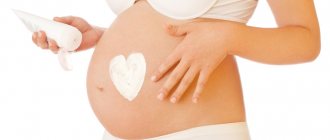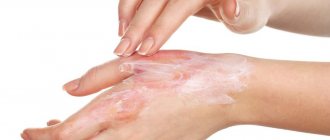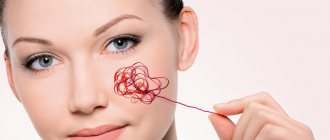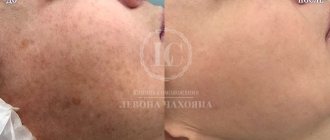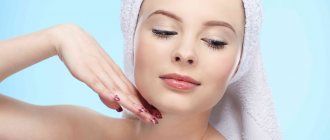During pregnancy, a woman's body undergoes hormonal, physiological and emotional changes. These changes affect all organs and systems, including the skin, because its condition and appearance are directly dependent on the condition and processes that occur in the body as a whole.
Factors influencing changes that occur in the skin during pregnancy:
- initial skin condition
- hormonal status
- features of pregnancy
Even seasonality and changes in diet can affect the condition of the skin during pregnancy.
Why are there pigment spots during pregnancy?
The reason for the appearance of spots is hormonal changes that occur in a woman’s body during pregnancy. Theoretically, after feeding is completed and hormonal levels are restored, pigmentation returns to normal and the spots disappear.
But in practice this does not happen . Pigment cells melanocytes have cellular memory and, despite the absence of increased amounts of hormones, continue to produce excess amounts of melanin locally. The pathological process is aggravated by UV rays , to which melanocytes become especially sensitive.
A study was conducted with the participation of 324 women. The main causes and provoking factors for the development of pigmentation have been identified:
- Ural Federal District
- Pregnancy
- Taking oral contraceptives
- Endocrine disorders
- Genetic predisposition
- Intake or external use of photosensitizers
*often a combination of several factors occurs
The main provocateur of pigmentation, among other disorders, is solar radiation . Under the influence of UV rays, the synthesis of melanocrine is induced - a hormone of the pituitary gland, which activates the work of pigment cells.
Causes of postpartum hyperpigmentation
The changes that occur to the skin during pregnancy are in most cases physiological. This means that they occur frequently and regularly, and are a manifestation of a normal pregnancy, do not have a negative impact on the health of the mother and fetus, being limited to transient cosmetic defects.
Three types of hormones are responsible for the appearance and condition of the skin:
- female sex hormones (estrogens)
- pregnancy hormone (progesterone)
- melanocyte stimulating hormone
Estrogens regulate the secretion of the sebaceous glands, reducing it. This means that if before pregnancy you had oily and problematic skin, then pregnancy will have a beneficial effect on the condition of your skin, it will not be so oily, and acne will decrease. Those with dry and normal skin are less fortunate. After all, their skin, which secretes an already insufficient amount of sebum, will become drier. This will manifest itself in the form of skin tightness, flaking, itching and various allergic reactions.
Progesterone affects skin elasticity. Its fluctuations can make the skin thinner and more sensitive. However, the opposite effect is also possible - the appearance or worsening of acne.
Melanocyte-stimulating hormone is responsible for skin pigmentation. An increase in its content leads to hyperpigmentation.
The incidence of hyperpigmentation during pregnancy is very high. Hyperpigmentation usually affects areas of the skin that are initially more heavily colored. In these areas, the content of pigment cells is higher and, as a result, sensitivity to hormonal changes is higher. Areas most susceptible to hyperpigmentation:
- areolas of the mammary glands
- armpits
- vulva
- anus
- inner thighs
- linea alba
- facial skin (the so-called “pregnant mask”)
Moles, freckles and birthmarks that existed before pregnancy often increase in size and darken. The appearance of new moles and age spots is possible. Exposure to sunlight worsens pigmentation. Therefore, it is necessary to avoid sun exposure and use sunscreens with a high protection factor. Hyperpigmentation is especially pronounced in dark-haired and dark-skinned women.
How to get rid of age spots after pregnancy
During pregnancy
- Avoid direct sunlight , do not expose to open sun, use caps, hats, sun umbrellas;
- Apply sunscreen with SPF daily . During pregnancy and after, it is preferable to use a mineral SPF based on zinc oxide or titanium dioxide. These products are hypoallergenic, do not penetrate the skin, but lie in an even, imperceptible layer on the surface of the skin, creating a mineral screen from all types of UV rays.
During lactation
- Continue to protect your skin from ultraviolet radiation as during pregnancy
- Start using lightening agents that meet the requirements:
- without irritating and toxic effects
- combined composition of ingredients with different mechanisms of action on pigmentation
- free of retinoids, hydroquinone and acids
You should not wait for the end of feeding and recovery; it is possible and advisable to extinguish the increased activity of melanocytes already in the present moment.
Methods for treating hyperpigmentation after childbirth
Chemical peels
The procedure is based on exfoliation of the upper layers of the epidermis due to the action of various acids. Due to this, the skin texture is renewed and smoothed. The choice of peeling depends on the depth of pigment penetration.
Mesotherapy with vitamin C
Microinjections of mesococktail into the dermis with the creation of an intradermal depot of the drug. Vitamin C has a lightening effect on age spots. The course is prescribed individually depending on the age and severity of age spots, age and skin characteristics.
Phototherapy and AFT therapy
The main mechanism is the selective effect of pulsed light on the melanin pigment. There is no damage to the skin and surrounding tissues. After the first procedure, the result is already noticeable. The pigment spot becomes less pronounced. But this does not happen immediately, but about a week after the procedure.
Laser peeling or laser facial resurfacing
Perhaps the most radical method of combating hyperpigmentation. Allows you to remove old, deep-lying pigment spots. The essence of the method is alternating zones of evaporation of the epidermis with intact tissue. Due to healthy skin fractions, rapid healing and restoration of damaged tissue occurs.
As you can see, there are many methods for treating hyperpigmentation after childbirth. The choice of the procedure that is right for you depends on many of the factors described above. For more detailed information, please contact our medical center. We will be happy to help you enjoy the beauty of motherhood! And age spots will not upset you!
What products to use during pregnancy and lactation
Mineral cream SPF 30 with zinc DermaQuest based on micronized zinc oxide 18.6%.
Sunscreen for all family members from babies to pregnant mothers!
Advantages:
- Does not penetrate deep into the skin
- Absolutely safe and hypoallergenic
- Broad spectrum skin protection against all types of UV rays: UVA and UVB
- There are no contraindications for use - it can be used by young children and pregnant women
- Blocks up to 97% of sun rays
- In 2022, the composition is enriched with BlueLight filters against blue light
Tone cream SPF30 with zinc for the face DermaQuest - for working mothers, as well as for those who do not like pale skin color.
An analogue of mineral cream with SPF30, which contains pigments that give the skin a light tan.
CBD "Blue Light" face cream SPF 30 DermaQuest - for those mothers who, despite maternity leave, spend a lot of time in front of a computer monitor, tablet or smartphone, as well as for those with sensitive or irritated skin.
This is a complete day cream with protection against the entire spectrum of radiation to get rid of pigmentation and prevent aging!
How does it work:
- Protects skin:
- from dryness and dehydration
- from ultraviolet rays of any intensity
- from oxidative stress
Contains:
• Mineral SPF – zinc oxide – broad-spectrum protection, anti-inflammatory effect;
• Cannabidiol is a plant ingredient with healing, soothing and restorative effects. Ingredient – BOOM2019, used in medicine;
• InfraGard – filter against blue light – prevention of premature aging;
• BV-OSC – active form of vitamin C – antioxidant, normalizes skin color and increases its elasticity;
Application:
Daily in the morning after your regular serum. One application is enough!
DermaQuest SkinBright serum and cream are a combination that enhances each other’s effectiveness.
Advantages:
- Rich composition of safe brightening ingredients
- Does not require additional skin care products
- Moisturize, nourish, have an antioxidant effect
- Prevention of age-related changes
Contains:
- Stem cells of Lily Snow White
- Melanostatin-5 (brightening peptide)
- Chromebright
- Bakuchiol A (Vitimon A simulator without the irritating effects of retinoids)
- Hexylresorcinol – 4 times more active than hydroquinone in lightening effect
- Emblica – plant extract
- Kojic acid dipalmitate
- Bearberry, licorice root and white mulberry extract
- Arbutin
SkinBright preparations do not contain Hydroquinone!
They do not have an irritating effect, have a moisturizing and nourishing effect, making them a complete treatment used morning and evening for the entire face. There is no need for local application and the purchase of additional care products!
What to do if stains don't go away
If your skin's genetic biology predisposes you to be highly pigmented, it will be difficult to do anything about it after dyeing it dark. Spots that cover the body for more than 1 year may indicate the development of pathology. In this case, you need to seek help from a dermatologist and undergo a diagnostic examination.
The most likely causes of prolonged pigmentation after childbirth:
- Gastrointestinal pathologies. The defect persists in the forehead area;
- Problems with the thyroid gland. Melasma stays around the eyes;
- Hormonal disbalance. Pigmentation covers the nose and cheeks, localized above the upper lip and on the chin.
Factors that increase the risk of developing pigmentation
The likelihood of pigment spots appearing after childbirth increases due to a number of reasons.
The main ones:
- constant stress that has a bad effect on metabolism;
- lack of vitamins (especially folic acid);
- prolonged exposure to the sun;
- gastrointestinal diseases;
- thyroid diseases.
Heredity plays a big role. The predisposition to pigmentation is transmitted at the genetic level. It is enough to look at photos of mothers and grandmothers to predict the manifestation of postpartum spots in yourself.
Contraindications to the use of anti-pigmentation products
For a young mother, the main thing, while restoring her attractiveness, is not to harm the baby’s health.
Anti-pigmentation agents should not be used:
- until the child is 3 months old;
- if the mother or newborn has a tendency to allergic reactions;
- when there are microdamages, rashes, and areas of inflammation in the treatment area;
- if there are contraindications to the use of a particular cream.
It is prohibited to lighten spots caused by dermatological diseases - such marks will go away on their own after complete recovery.
Hair health
Hair loss is one of the most pressing problems of a young mother, and it usually attacks 2 to 3 months after childbirth. Don't worry: this happens under the influence of hormones. Hair will stop falling out in about six months, and a new “undercoat” will appear in place of the bald patches. Here's how you can help your hair:
- Daily head massage for better blood supply to hair follicles;
- Masks against hair loss based on essential oils;
- Mesotherapy procedure for the scalp;
- B vitamins (found in oatmeal, seafood and bran).
It is better to refrain from dyeing your hair in the first six months after the birth of your baby. And the point is not that the dye will reach the child through milk (this is a myth) - during active hormonal changes, the hair can react to the dye in the most unexpected way.
Prevention
To avoid the occurrence of pigmentation after childbirth, you need to include more vitamins in your diet and hide your face, hands, neck and décolleté from the sun during pregnancy. It is allowed to use plant-based creams with a high level of UF protection, but it is better not to go outside on hot days - this will preserve the skin and its healthy color.
Pigment spots after childbirth are a temporary phenomenon. Don't be upset by their occurrence. In most cases they disappear on their own. Pharmacy and folk remedies and salon procedures will help speed up the process. If melasma does not go away within a year, you need to consult a doctor and start treating the cause of pigmentation.
Photo: yandex.ru
Life in a new rhythm
- Be calm about changes in appearance after childbirth. Now you are at the peak of your femininity and beautiful with a special maternal beauty. People around you see your gentle smile and the sparkle of your eyes, and not stretch marks and excess weight;
- Lower your expectations. Perhaps you used to never go out without makeup and had your nails done at the salon every week. Now priorities have changed, but not forever;
- Smile more often. It lifts your mood, improves your complexion and trains your facial muscles. What could be more beautiful than a smiling young mother!;
- Update your wardrobe. Even if your weight has not yet returned to normal, this is not a reason to deprive yourself of beautiful clothes of the right size. Buy at least one dress and a lounge suit;
- Get help. Ask your husband or grandmothers to spend an hour or two with your baby at least once a week. Dedicate this time to yourself: bath with aroma oils, manicure, peeling, face mask;
- Don't skimp on yourself. Often young mothers live by the principle “everything is best for the child,” but instead of purchasing another pair of designer onesies, it is better to buy something for yourself: a good cream, a new dress;
- Eat right. This will reduce your baby's risk of food allergies and help you get in shape faster. A nutritious diet is now as important for your health and beauty as sleep.
And yet, after giving birth, there have probably been some changes in your appearance. Most often, young mothers are bothered by stretch marks, poor complexion, hair loss and brittle nails. How to deal with these problems?
Safe cosmetics
Even if you are not breastfeeding, after giving birth you should think about the safety of your decorative and skincare products. Being in constant contact with your baby, kissing and hugging him, you can provoke an allergic reaction by using a cream with aggressive ingredients. Give preference to organic cosmetics and avoid products with the following ingredients:
- Mineral oil;
- Parabens;
- Sodium lauryl sulfate (aka sodium lauryl sulfate);
- Phenoxyethanol;
- Aluminum salts;
- Methylchloroisothiazolinone and methylisothiazolinone.
Remember that there are at least two people for whom you are the most beautiful woman in the world: your baby and your husband. Bloom under their admiring glances and don’t feel complex about minor postpartum problems, of which soon there will be no trace left.
